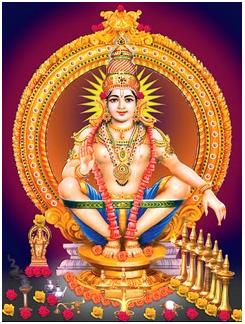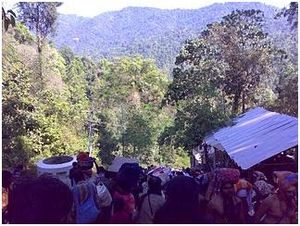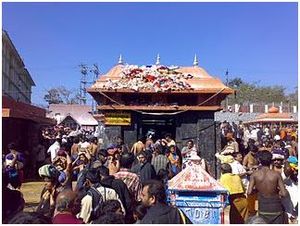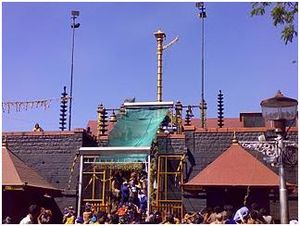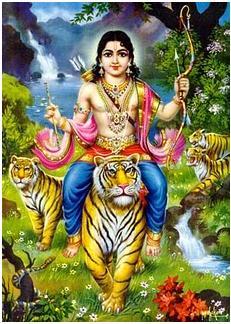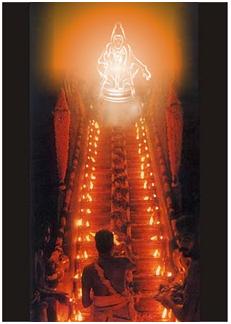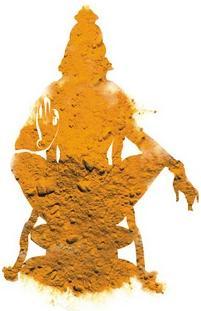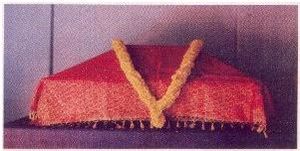Sabarimalai Sri Ayyappan
Sabarimalai is situated amidst the dense forests in Sahya hill (Sahyadri) range in Pathanamthitta District of Kerala. The temple (Sannidhanam) is located on the hill top, at an altitude of 4135 ft. To reach the temple, one has to trek through the hills by walk in the dense forest range. According to both history and mythology, Lord Ayyappa is the last and only God belonging to the present Kaliyugam. A demon female called Mahishi, performed severe penance towards Lord Brahma to take revenge against Devas who were responsible for the death of her brother Mahishasura. Mahishasura was killed by Mahishasuramardhini (Kali) as per Devas’ prayers.
Lord Brahma appeared to Mahishi and told her that she can ask for any boon except immortality. Mahishi prayed Lord Brahma that she should get such powers that no one should be able to kill her except a son who is born out of the union of Lord Shiva and Lord Vishnu. She cleverly asked such a boon as both Lord Shiva and Lord Vishnu were male Gods. Brahma offered her the boon. Mahishi started troubling Devas as the revenge.
A demon king called Bhasmaasura performed penance praying Lord Shiva. When Lord appeared to him, he asked for a boon that whoever he touches should turn into ashes. The Lord granted him the boon. Bhasmaasura just couldn’t believe it and wanted to test it on Lord Shiva Himself. Lord Shiva went and requested Lord Vishnu to rescue him. Lord Vishnu took the form of a Mohini (a beautiful woman), and went to Bhasmaasura. On seeing her beauty, he wanted to marry her. Mohini agreed to it with a condition that he should touch his head and swear that he will not think of any other woman after marrying Mohini. Bhasmaasura innocently touched his own head and turned into ashes.
Lord Shiva saw Lord Vishnu who was in the avatar of Mohini. He got attracted with the beauty of Mohini, and there happened the union of Lord Shiva and Mohini (Lord Vishnu), out of which a male child was born to them. He was named Dharma Saastha who was growing up in Kailash, the abode of Lord Shiva. He was also called Hariharan as he was born to Hari (Vishnu) and Hara (Shiva). During the Pandya dynasty, while the Pandyas were ruling parts of Kerala apart from Tamilnadu, the descendants of the dynasty were given the rights to rule the country of Pandalam.
One such king called Rajasekara, who was the direct descendant of the Pandya dynasty was ruling Pandalam region. King Rajasekara was very successful as a king, keeping his kingdom prosperous. The king had only one worry in life that he had no children to take up the responsibility after his tenure. The king and the queen prayed Lord Shiva for blessing them with a child. Lord Shiva decided to answer their prayers through Dharma Saastha. He directed Dharma Saastha to be born as a baby and grow up in Pandalam. Lord Shiva along with Mohini left the baby in the dense forests on the banks of River Pampa, which was in Pandalam territory of Rajasekara.
One day, while Rajasekara went for hunting, he was resting in a place after a tiresome hunt. He heard a noise of a baby crying. He went around and saw a beautiful male baby left alone in the forest. He was astonished to see the baby with a golden bell tied around the neck. While he was confused on what to do with the baby, a sage who was passing by told him that the baby is so divine and reminded the king of his prayers to Lord Shiva for blessing him with a baby. He also said that the baby is not a normal human being and an avatar of God himself.
As there was a bell tied around the neck, the sage named the baby “Manikandan” (Mani means bell and Kanda means neck in Tamil) and advised the king to take the baby to the palace and bring him up. He also told that the king would realize the purpose of the boy’s birth when He turns 12. The king was too happy and took the baby to the palace and brought him up. The queen and everyone in the kingdom were very happy that the king now had an heir to succeed. There was a Diwan (minister) in the kingdom, who was planning to take over the rule as the king didn’t have a successor, now got worried.
As the child grew up the king sent him to Gurukulam, where he learnt various arts and excelled. Everyone was surprised to see Manikandan being the best among others, with his brilliance and divinity. After completing his studies from his Guru, Manikandan wanted to offer Guru Dhakshina to him. Guru said that his only worry was about his son, who was dumb. Manikandan made him speak instantly. Guru was too happy about his son who got back his speech and to see the divine powers of Manikandan.
Few years later, the queen gave birth to another male child. They named him Raja Rajan. Both the sons grew up happily. One day king Rajasekara decided that the time has come to crown Manikandan as his successor, as he was the eldest. He ordered the Diwan to make necessary arrangements. But the Diwan was not for it as he already had a grudge against Manikandan. He went to the queen and spoiled her mind and made her go against the king’s decision. He told the queen that only Raja Rajan is qualified to be a successor, as he was actually born to them. The queen took his words and started believing him. He also told that he will take care of elimination of Manikandan, so that the queen won’t be blamed. He told the queen to act as if she had a severe stomach pain.
The queen followed his words and started acting as if she suffered an intolerable stomach pain. Diwan arranged for a doctor who told the king that, the only medicine for queen’s pain is the Tigress’ milk. While the king was planning to send his men for it, Manikandan volunteered to go to the forest and fetch the tigress’ milk, for which the king refused, as Manikandan was proposed to be crowned. But Manikandan insisted and made the king to accept him go. Manikandan went alone into the forests to fetch milk from tigress. He carried a bag on his head containing necessary food etc., during his search in the forest.
On his way, he realized the purpose of his incarnation on earth. As Mahishi had a boon that she can only be killed by a son born to Lord Shiva and Lord Vishnu, Ayyappan realized his duty to save Devas from Mahishi. By then Mahishi was at her peak in devastating Devas and their places. Manikandan on his way to forest pulled her for a fight and waged a strenuous battle with her. Knowing this, Lord Shiva came down to earth along with Parvathi Devi on His Rishaba Vaahana (Ox – His carrier). He tied the Ox in a near by tree in the forest and watched Manikandan fighting with Mahishi. The place where he tied the Ox is called as Kaalaikatti (Kaalai means Ox and Katti means tying) which is on the banks of River Azhudha, on the way to Sabarimalai. There is a Shiva temple now at Kaalai Katti.
Manikandan defeated Mahishi and threw her on the ground. Doubting that she may come alive again, Manikandan threw huge stones on her to ensure that she can’t come up again. This place is called Kallidum Kunru on the Azhudha hill, where even today, pilgrims pick up a stone from Azhudha River and throw it in this place marking Mahishi’s defeat.
Once Mahishi died, Manikandan blessed her to reach heaven. Mahishi who got relieved of some past curse with an opportunity to die from the hands of God Himself, prayed Manikandan to marry her. But He refused saying that, his birth on earth had a different purpose and he was meant to live as a Brahmachari throughout. But as Mahishi insisted, Manikandan told her that she can take abode in the same forest meant for him and assured her that whenever there is no new devotee coming to see Him, He would marry her.
From then Mahishi took abode just near the Sannidhanam with the name Maligapurathamma. Till today, she is eagerly waiting to see that no new devotee is visiting Ayyappan, but in vain. Because, every year, thousands of first timers (called Kanni Samis) visit Sabarimalai. To mark their visit, they bring a sharp bamboo stick called Saram and fix it on a tree at a place called Saram Kuthi. It is believed that when there is no “Saram” fixed on the tree, Lord Ayyappa would marry her, which never happened. On seeing Manikandan killing Mahishi, Lord Shiva and all Devas were too happy and showered him with praises. Lord Indra, along with all Devas volunteered to become tigers and tigresses and accompanied Manikandan back to the kingdom. Manikandan entered the palace sitting on a tiger, followed by a huge group of tigresses. The entire Pandalam and Palace was shocked to see this happening. Everyone started running for life on seeing this.
Rajasekara realized that Manikandan was not an ordinary child. As told by the sage in the forest that Manikandan’s intent of birth would be known at his age of 12, Manikandan had reached the age of 12 by then. The queen and diwan fell at Manikandan’s feet for His pardon. But Manikandan said it’s not their mistake and everything happened for a cause, with God’s blessings. King Rajasekara apologized with Manikandan and requested him to take up the throne which was his dream of life. Manikandan politely refused and said that, becoming a king was not the purpose of his birth. He said His duty on earth is over and wanted to perform penance to reach back to Kailash.
King Rajasekara told Manikandan that he wished to construct a temple for Him, in a place wherever He chooses. Manikandan took his bow and shot an arrow, saying that he would be on Thapas in the place where the arrow falls. The arrow went and fell at this place called Sabarimalai, which was already a holy place, where an old lady called Sabari, a devotee of Rama lived. She always was chanting the name of Rama and wanted to meet Him at least once in her life time. Rama met her in this place and accepted her hospitality. As Sabari lived in this hilly forest, it was called Sabarimalai.
Manikandan said that he would be meditating in Sabarimalai and would be called as Ayyappan by his devotees. He also said that whoever visits him has to undergo a severe Brahmacharya Vratham (fast) and must abstain from worldly pleasures for 41 days before coming to Sabarimala. He would be blessing the devotees from Sabarimala near the river Pampa, which is as sacred as River Ganga.
Rajasekara who was eager to see Ayyappan as a king, felt very sad to see him as a Sanyasi with saffron clothes. Ayyappan granted a boon to Rajasekara that, every year on Makara Sankaranthi day, He would give Dharshan to the world as a king, with all costumes and weapons, a king would adorn. He also said that He would give appear in the form of a Jyothi (light) on that day, which happens till today on every Sankaranthi. After this, Manikandan proceeded to Sabarimala on his celestial journey.
Later, king Rajasekara, as per advice of Sage Agasthiyar, laid the foundation for constructing the shrine for Ayyappan in the said place. When king Rajasekara didn’t know how to personify the image of Ayyappan in the temple, Sage Parasurama came to his help, carved the image of Lord Ayyappan and installed it on the day of Makara Sankaranthi.
The temple shall be reached by walk either from Erumeli or from Pampa. The trek from Erumeli (called Peruvazhi) is strenuous and about 48 kms (approx.) by walk. The route from Pampa is about 6 kms which is shorter but steeper too. People also take another route to reach the temple which is called Pul Medu (meaning Grass Hills). The temple (Sannidhanam) is located amidst a serene beauty of nature, surrounded by hilly forests. One has to climb 18 steps to reach the sanctum. It is believed that the holy 18 steps denote 5 Indriyas (senses), 8 Ragas, 3 Gunas (characters), Vidya and Avidya. It denotes that once a person crosses these 18 stages he can reach the supreme God.
Devotees undergo severe austerities during 41 days fasting and start their pilgrimage to Sabarimala. One has to carry the Irumudi (a bag containing 2 portions) on his head throughout the journey. In the front portion, the Ghee is carried inside a 3 eyed coconut for Abhishegam to the Lord. The back portion contain the food stuff is carried for cooking in the forest, as one won’t get any food in the forest. When one reaches the Sannidhanam, the back portion would be empty and the front portion containing Ghee is offered to the Lord. It signifies that, only when we reduce all our sins and worldly pleasures, we can reach the Almighty. Devotees break a coconut in front of these 18 steps (Pathinettaampadi) before ascending. People without Irumudi are not permitted to climb the holy steps.
On Sankaranthi day, the jewels, clothing and weapons which from the Pandalam Palace is brought to Sabarimala to be adorned by the Lord. This entire Jewel box (called Thiruvaabaranam) is carried by the persons or their representatives belonging to the Pandalam King’s family ancestrally, who walk down all the way from Pandalam to Sabarimala. The Thiruvaabaranam is kept at a Sri Parthasarathy Swamy Tempe at Aranmula, as a ritual, on the way to Sabarimala. A Brahman Kite (Garuda) accompanies Thiruvaabaranam right from Pandalam till Sabarimala.
Sankaranthi is the only day, where one can have dharshan of the God dressed up like a king. For the rest of the year, God gives dharshan here as a Sanyasi wearing Saffron clothing and a garland made of Thulsi beads with the bell tied around his neck. On Makara Sankarandhi day, a star appears on the sky at a particular time in the evening, after which a light, Makara Jyothi appears for a while, amidst the adjoining hill called Ponnambala Medu. Lakhs of devotees excitingly witness this rare event every year, chanting “Swamiye Saranam Ayyappa”.
There is a separate shrine for Sri Vavar near the Sannidhanam which is called Vavaru Nada. Vavar is a Muslim friend of Lord Ayyappa who was a bandit in the forest. Vavar first had a fight with Ayyappa on his way to Sabarimala. Later knowing the powers of the Lord he surrendered to Him. Ayyappan accepted him as his best friend, who accompanied and helped Ayyappan throughout his way to Sabarimala. One can see a Muslim priest here blessing the devotees. Thus, Sabarimala marks the Hindu – Muslim unity. A Muslim shrine inside a Hindu temple is a rare sight which is not seen anywhere else in the world.
Even these days, people who start their trek from Erumeli, visit Vavar’s Mosque situated opposite Dharma Saastha temple to seek his blessings and guidance throughout the hilly forests. Other deities of the temple are Sri Ganapathy, Naagar, Maaligappurathamman, Nava graham, Kochu Kadutha Swamy and Valiya Kadutha Swamy. The temple attracts crores of devotees every year and it has the record of being the world's second largest annual pilgrimage, next to Haj. A must visit temple at least once in the life time. There are also few other mythologies and history connected to this temple. I have narrated the above, with what is widely told and believed by many, for generations. Your valuable comments are invited.

